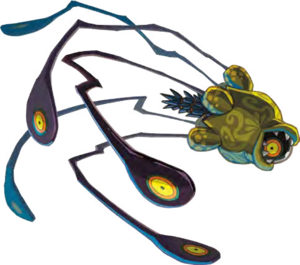What do you Love about Phantom Hourglass?
Posted on July 22 2013 by Legacy Staff
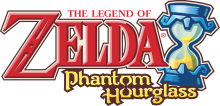 At the request of hollander, Phantom Hourglass has been selected as the eighth entry to this series. It took awhile, but we’ve finally reached a handheld title, and if I do say so myself, one of the weakest games in the franchise. I will defend any Zelda game, as I think they are all spectacular, but Phantom Hourglass is by far my least favorite handheld Zelda game, and down there with Four Swords for least favorite, period. I have many reasons for feeling this way, but remember that this is not the place for that! We’re here to discuss the best of each Zelda game, not the worst. If you have gripes, you are more than welcome to address them, I just kindly ask that you keep the negativity to a minimum. Focus on what the game did well. And despite this game ranking very low among my favorite Zelda games, I do think that the touchscreen title did many things extremely well that made it as good as a game lacking traditional controls could be. Hit the jump to read more!
At the request of hollander, Phantom Hourglass has been selected as the eighth entry to this series. It took awhile, but we’ve finally reached a handheld title, and if I do say so myself, one of the weakest games in the franchise. I will defend any Zelda game, as I think they are all spectacular, but Phantom Hourglass is by far my least favorite handheld Zelda game, and down there with Four Swords for least favorite, period. I have many reasons for feeling this way, but remember that this is not the place for that! We’re here to discuss the best of each Zelda game, not the worst. If you have gripes, you are more than welcome to address them, I just kindly ask that you keep the negativity to a minimum. Focus on what the game did well. And despite this game ranking very low among my favorite Zelda games, I do think that the touchscreen title did many things extremely well that made it as good as a game lacking traditional controls could be. Hit the jump to read more!
Linebeck
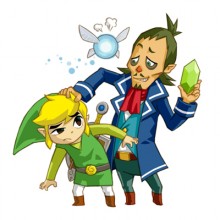 I don’t know about anyone else, but when I think Phantom Hourglass, the first thing that comes to mind is Linebeck, the ironically boastful coward. In my article “Who’s Your Favorite Partner?” I mentioned that he is among my absolute favorite Zelda characters. His usefulness is matched only by his comic relief. Most humorous characters that have appeared in Zelda games have been minor, but Linebeck plays a major role and tags along with you throughout your adventure. He is also one of the most dynamic characters in the series. At first a self-absorbed treasure obsessor, he joins Link on his quest in the hopes of striking it rich. However, by the end of the game he is granted a wish, and rather than riches he wishes for the reconstruction of his ship, which was destroyed earlier in a battle with Bellum. This wish proves that there was more to Linebeck under his selfish surface, and that life is not so much about reaching an ultimate goal as much as it is about living for the moment and enjoying the time you have. He definitely makes one my least favorite Zelda games all the more fun and worth playing.
I don’t know about anyone else, but when I think Phantom Hourglass, the first thing that comes to mind is Linebeck, the ironically boastful coward. In my article “Who’s Your Favorite Partner?” I mentioned that he is among my absolute favorite Zelda characters. His usefulness is matched only by his comic relief. Most humorous characters that have appeared in Zelda games have been minor, but Linebeck plays a major role and tags along with you throughout your adventure. He is also one of the most dynamic characters in the series. At first a self-absorbed treasure obsessor, he joins Link on his quest in the hopes of striking it rich. However, by the end of the game he is granted a wish, and rather than riches he wishes for the reconstruction of his ship, which was destroyed earlier in a battle with Bellum. This wish proves that there was more to Linebeck under his selfish surface, and that life is not so much about reaching an ultimate goal as much as it is about living for the moment and enjoying the time you have. He definitely makes one my least favorite Zelda games all the more fun and worth playing.
Intriguing Dual Screen Puzzles
It’s been awhile since I’ve played this game, so I’m sure I will forget to mention some truly inventive puzzles while discussing this aspect. It seems that no idea was left un”touched” (get it?) when it came to utilizing the unique two-screen system. Remember that frustrating, “literally close the system” tactic you had to use to place the mark of Farore on your Sea Chart? Annoying, but thoughtful nonetheless. Or how about the boss fight with Crayk? Definitely one of the most fun battles in the game, you had to look at the top screen when the beast went invisible to see the arena from his point of view. You then had to look between each screen before he caught up to you to make sure you were lined up with your bow to shoot him. While this certainly isn’t one of my absolute favorite bosses in the series, he was easily one of my favorites in the game, due to the strategy the game developers incorporated to the system. Nintendo has always taken full advantage of each system’s capabilities to make the best Zelda experience possible, and while I feel the touch games are the weakest in this sense, they still shine regardless. These are still top-notch touch controls that make playing a game with a pen rather than buttons as fun as possible.
Item Control
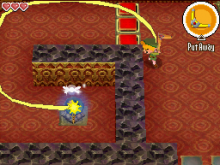 If there’s one thing the touchscreen Zelda games do better than any other Zelda games, it’s the amount of control you have over your items. The bow’s accuracy can be pinpointed to where you touch, which can be much faster than in other games in the series. Bombs are thrown exactly where you touch, and you can throw them either short or long distances from one spot. But the most creatively designed items in this game are the boomerang and Bombchus. These items definitely made for some of the most creative and entertaining puzzles in the game. The boomerang was able able to lock onto multiple targets in previous games, but now the incredibly handy item can travel exactly in the path you choose. It is just as much a tool as it is a weapon, and I don’t think I’ve ever had as much fun with it before. In past titles, Bombchus could be a frustrating item to use, as being slightly out of alignment from your target could make the device miss completely. Here, they can travel in any path you can draw. You can make those suckers zig zag, go in circles, go through holes in the walls, whatever. When it comes to item control, Phantom Hourglass and Spirit Tracks destroy the competition.
If there’s one thing the touchscreen Zelda games do better than any other Zelda games, it’s the amount of control you have over your items. The bow’s accuracy can be pinpointed to where you touch, which can be much faster than in other games in the series. Bombs are thrown exactly where you touch, and you can throw them either short or long distances from one spot. But the most creatively designed items in this game are the boomerang and Bombchus. These items definitely made for some of the most creative and entertaining puzzles in the game. The boomerang was able able to lock onto multiple targets in previous games, but now the incredibly handy item can travel exactly in the path you choose. It is just as much a tool as it is a weapon, and I don’t think I’ve ever had as much fun with it before. In past titles, Bombchus could be a frustrating item to use, as being slightly out of alignment from your target could make the device miss completely. Here, they can travel in any path you can draw. You can make those suckers zig zag, go in circles, go through holes in the walls, whatever. When it comes to item control, Phantom Hourglass and Spirit Tracks destroy the competition.
Drawing on the Maps
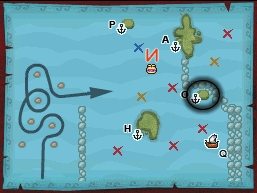 Being able to draw on your maps opens the door for some very interesting puzzles, and Phantom Hourglass does not disappoint. From taking notes to remember to pull which levers in which order, to lining up intersecting paths to pinpoint an underground path, to drawing symbols on doors to unlock them, using a pen to play a game couldn’t get more exciting. I know that sounds sarcastic, but I really do mean it. The Zelda team could’ve just created a game that utilized touch screen controls only for moving and attacking, but they took the time to make drawing not only an essential aspect of the game, but quite an exciting one too. Anyone who knows me knows that I like my Zelda brain teasers. One thing that has always bumped Zelda above other franchises for me is its ingenious puzzles that require you to think. Many games are simply beat ’em ups and stealth focused, but Zelda makes you use your brain. The drawing puzzles may not be action packed, but they certainly are creative and I found them to be one of the best parts of the game. While replaying this game, I can think of a million and one things to dislike, but doodling on your map for notes and unlocking new areas is a fresh approach that the Zelda team incorporated masterfully, and is one of the few activities I look forward to utilizing.
Being able to draw on your maps opens the door for some very interesting puzzles, and Phantom Hourglass does not disappoint. From taking notes to remember to pull which levers in which order, to lining up intersecting paths to pinpoint an underground path, to drawing symbols on doors to unlock them, using a pen to play a game couldn’t get more exciting. I know that sounds sarcastic, but I really do mean it. The Zelda team could’ve just created a game that utilized touch screen controls only for moving and attacking, but they took the time to make drawing not only an essential aspect of the game, but quite an exciting one too. Anyone who knows me knows that I like my Zelda brain teasers. One thing that has always bumped Zelda above other franchises for me is its ingenious puzzles that require you to think. Many games are simply beat ’em ups and stealth focused, but Zelda makes you use your brain. The drawing puzzles may not be action packed, but they certainly are creative and I found them to be one of the best parts of the game. While replaying this game, I can think of a million and one things to dislike, but doodling on your map for notes and unlocking new areas is a fresh approach that the Zelda team incorporated masterfully, and is one of the few activities I look forward to utilizing.
Easy Sailing
The Wind Waker is notorious for having chunks of boring, sailing gameplay. Sure, treasures and enemies were thrown your way occasionally to keep things quasi-exciting, but ultimately I used these moments as bathroom breaks, they were so uneventful and dull. In Phantom Hourglass, just draw your path and you’re on your way! I know many fans prefer the active steering of The Wind Waker, but generally you wouldn’t steer much at all when out at sea. Think about it: you would usually look at your map to see in what exact direction your destination was, then set your wind direction and path directly toward your goal. You only steered off track to engage enemies or pull up sunken treasure. You can do that in Phantom Hourglass too, but this handheld title also keeps things more eventful by throwing more obstacles your way, such as Sea Traps, Ocean Octoroks, Eyeball Monsters, Mini Cyclones, Flying Fish, and Cannon Boats. True, The Wind Waker had some of these too, but in Phantom Hourglass they were much more common. You couldn’t travel for ten seconds without running into one of these things. And as an added bonus, the sea is relatively small, making your eventful travel time on the sea seem even shorter.
Bellum Boss Fight
In a series plagued with easy boss battles, Bellum challenged me. Of course I can defeat him quite easily now, but I still do find both phases engaging in terms of difficulty. You have to be on your toes when facing this beast. I love the stair-climbing phase where you must run around, lining up and timing your bow to weaken Bellum’s tentacles while fighting off oozy minions. While I did not find this stage particularly challenging, I did find it extremely fun. But of course, a final boss is rarely defeated in one form, and I would have to face the monster once again. In terms of gameplay, I prefer stage one. But in terms of story and atmosphere, I prefer stage two by far. A piece of wood from a destroyed ship floating on a murky sea with a dark sky looming in the background. And poor Linebeck is possessed after courageously stepping up and actually trying to help beyond providing transportation. This moment was the first time I died in the game, as Bellum dealt quite a bit of damage and it took me too long to figure out his attack pattern. Like the Crayk battle before it, this fight necessitates looking at both screens interchangeably to plan your attack. The way the story is presented here does not seem like an excuse to satisfy the DS gameplay the Zelda team wanted, but the two naturally fit together, and story and gameplay mix beautifully and make for one of the best climaxes the Zelda series has ever seen. There is a sense of immediate urgency in this battle, something that other final boss fights of the series sorely lack. I love the Bellum boss fight in terms of both gameplay and atmosphere, and rank it quite high compared to others in the series.
What do you all think? What do you love about Phantom Hourglass? Do you agree or disagree with the points above? Which game would you like me to discuss next? Comment below, and let’s talk about it!



